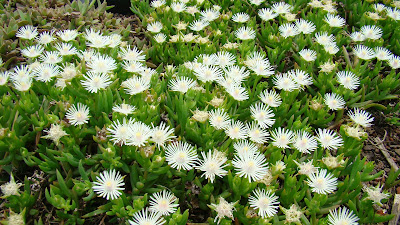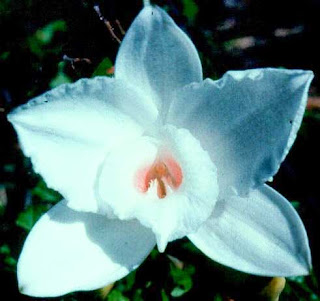Early in 2009 I became involved in the eThekwini Municipality Green Roof Pilot Project at which time I started the trial of a number of species of local plants at Mount Moreland north of Durban.
Delosperma
lineare
As from 1987, prior to becoming involved in the eThekwini Municipality Green Roof Pilot Project I had considerable exposure to green roof construction in Germany. Therefore, it was natural to copy as closely as possible the methods employed in green roof construction in Germany. Using drainage and engineered growing medium consisting of materials such as light weight expanded clay granules, perlite and vermiculite. In addition, we incorporated very little organic material as done in Germany with the percentage not exceeding 5%.
For many reasons it was decided
to limit our research to exclusively local indigenous plants that occur
naturally within 50 of the test site. In regards to my own testing I have added
a few plants collected in the very hot and dry Ndumo area.
This evaluation has been done after most of my test plants had been grown for ten years with virtually no attention, being left almost completely on their own with no watering, no fertilising, no addition of soils to the trays or mulching with compost.
Ten years later the evaluation of
the projects has proven that many of the practices carried out in Europe to not
be true for our circumstances.
Firstly, drainage appears to not
be essential because the drainage very soon becomes invaded by plant roots
which decrease or completely prevents its operation. The reality is that during
periods of heavy rain the majority of the water leaves the roof via surface
drainage.
Specially engineered soils appear to not be essential other than they are a little lighter a factor that can very easily be mitigated during the design stage of the roof to allow it to carry a little more weight.
Clearly a great range of South
African plants are extremely suitable for use on green roofs growing in shallow
relatively nutrient poor soils
Many indigenous orchids are ideal candidates for growing on nutrient poor green roofs, especially orchids from the genus Eulophia, in particular the very showy Eulophia speciosa.
Eulophia speciosa
All of the local indigenous bulbous
plants trialled have been an overwhelming success, one of the main reasons for
this appears to be that during the period of maximum growth there is sufficient
moisture for good growth from the rain with a dry period during the winter when
they are naturally dormant.
A number of new plants have
established themselves from seed that was blown in or brought in by birds. Of
particular note are Bulbine natalensis, Cyanotis speciosa, Delosperma lineare,
Drimiopsis maculata, the orchid Eulophia speciosa and a Plectranthus sp
collected at Ndumo.
Below are lists of plants that I
have trialled at my home in purpose manufactured planting trays most of which
have been in trialled for ten years the minimum period that plants have been
grown is 4 years.
|
Plants trialled that have done well |
|
|
Adenium multiflorum Aeollanthus parvifolius Agapanthus campanulatus Agapanthus praecox Albuca fastigiata Albuca setosa Aloe arborescens Aloe greenii Aloe tenuior Anthericum saundersiae Ceropegia nilotica Ceropegia stapeliiformis Crassula expansa Crassula lanceolata Crassula multicava Crassula obovata Crassula ovata Crassula pellucida Crassula perfoliata Crassula sarmentosa Cyanotis speciosa Cyrtanthus sanguineous Delosperma lineare Delosperma tradescantioides Dipcadi viride Drimia delagoensis Drimia elata Drimia flagillaris Drimiopsis maculata |
Drimiopsis maxima Eulophia speciosa Eulophia leitchii Eulophia citellifera Eulophia clavicornis Eulophia parviflora Eulophia unidentified Ndumo Cheilanthus viridis Gasteria croucheri Gladiolus cruentus Huernia histrix Huernia zebrina Hypoxis costata Kleinia fulgens Ledebouria apertifolia Ledebouria revoluta Murdannia simplex Ornithogalum sp. Dwarf bought Ornithogalum sp. Minute kloof Pelargonium alchemilloides Plectranthus neochilis Plectranthus creeping sp. Ndumo Scadoxus multiflorus Scilla natalensis Selaginella dregei Vera-duthiea zebrina Zingela pooleyorum |
|
Plants that have self-established |
|
|
Scadoxus puniceus Aloe maculata Aloe ferrox Euphorbia tirucalli |
Plectranthus madagascariensis Tetradenia riparia Kalanchoe rotundifolia |
|
Plants freely spreading from seed |
|
|
Agapanthus praecox Bulbine natalensis Crassula expansa Cyanotis speciosa Delosperma lineare Drimiopsis maculata Eulophia citellifera |
Eulophia speciosa Murdannia simplex Orbea longidens Ornithogalum sp. Dwarf bought Pelargonium alchemilloides Plectranthus creeping sp Ndumo Plectranthus neochilis |
Weeds
Bidens Pilosa established from
windblown seed although they are aesthetically unwanted, they complete their
life cycles or die from drought before they produce seed. Weeds have not been a
threat to the growth or the health of the plants.
Under normal conditions weeds
would need to be controlled mainly for aesthetic reasons as well as to keep the
plantings purely indigenous.
Establishment of grasses
In addition to unwanted annual agricultural weeds the grass Melinis repens has established in some of the trays during the rainy growing season dying off during the dry winter leaving seed to resprout with a onset of spring rains. Melinis is probably a good and certainly an attractive addition on most extensive green roof plantings.
Cyrtanthus sanguineous
Conclusion and recommendations
The vast majority of the plants
tested did extremely well.
Soil similar to the soils that
the plants are naturally found growing in produced the best results however all
plants grew satisfactory in a general fairly open well drained growing medium.
Occasional watering and the
removal of unwanted weeds would be of great benefit.
An annual mulching with either a
well-rotted and leaf mould of bark compost or animal compost such as sheep dung
appears to be of great benefit.
I would not recommend the
addition of inorganic fertilisers because they would promote weak rapid growth
of the plants
Michael Hickman
18.11.20










No comments:
Post a Comment